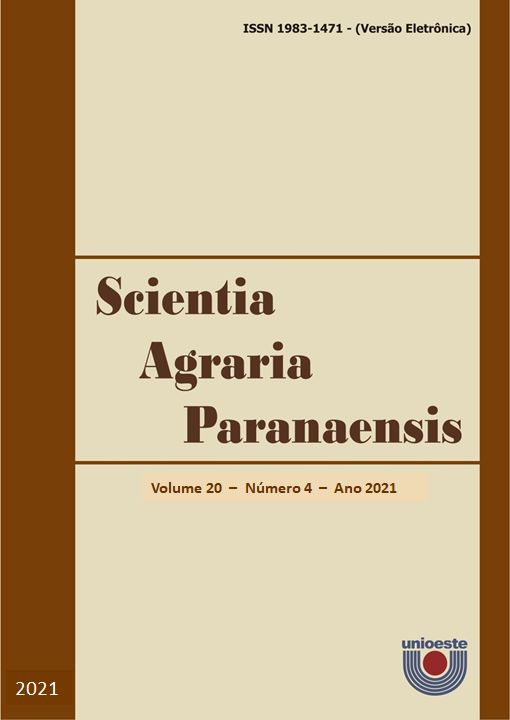Breaking seed dormancy in Sesbania punicea (Cav.) Benth
DOI:
https://doi.org/10.18188/sap.v20i4.27330Resumo
Sesbania punicea is a native plant of Brazil, has ornamental features inflorescences arranged in bunches of orange coloring. Its main form of propagation is through seeds, but these present integumentary dormancies, for which there is still no method of overcoming established. The objective of this study was to evaluate methods of breaking dormancy in S. punicea seeds for seedling production. The treatments used were control - no treatment, hand scarification with sandpaper grade 80 for 40 sec.; hand scarification with sandpaper grade 80 for 60 sec.; thermal treatment by soaking in water from 80ºC to room temperature and chemical treatment - stirring in 0.5 L solution of 12% sodium hypochlorite (NaClO), 3 mL of hydrochloric acid (HCl) and 20 g of commercial sodium hydroxide (NaOH) dissolved in 1 L of water, for 45 min.).After the treatments, the seeds were wrapped in rolls of autoclaved germitest paper and moistened with distilled water 2.5 times the weight of the sheet. Then, the rolls were placed in plastic bags, stored in the upright position, and incubated at 25ºC, in a 16 h photoperiod, for 14 days. A completely randomized design with four replications of 25 seeds was used. The germination percentage, average germination time, germination speed index, percentage of normal seedling formation, shoot length, root system length and percentage of hard seeds were evaluated. There was a difference for all the analyzes evaluated, except for the length of the aerial part. The dormancy breaking method through mechanical scarification using sandpaper for 60 sec., enables the propagation and formation of S. punicea seedlings.
Downloads
Publicado
Como Citar
Edição
Seção
Licença
Aviso de Direito Autoral Creative Commons
Política para Periódicos de Acesso Livre
Autores que publicam nesta revista concordam com os seguintes termos:
1. Autores mantém os direitos autorais e concedem à revista o direito de primeira publicação, com o trabalho simultaneamente licenciado sob a Licença Creative Commons Attribution que permite o compartilhamento do trabalho com reconhecimento da autoria e publicação inicial nesta revista.2. Autores têm autorização para assumir contratos adicionais separadamente, para distribuição não-exclusiva da versão do trabalho publicada nesta revista (ex.: publicar em repositório institucional ou como capítulo de livro), com reconhecimento de autoria e publicação inicial nesta revista.
3. Autores têm permissão e são estimulados a publicar e distribuir seu trabalho online (ex.: em repositórios institucionais ou na sua página pessoal) a qualquer ponto antes ou durante o processo editorial, já que isso pode gerar alterações produtivas, bem como aumentar o impacto e a citação do trabalho publicado (Veja O Efeito do Acesso Livre).
Licença Creative Commons
Esta obra está licenciada com uma Licença Creative Commons Atribuição-NãoComercial-CompartilhaIgual 4.0 Internacional, o que permite compartilhar, copiar, distribuir, exibir, reproduzir, a totalidade ou partes desde que não tenha objetivo comercial e sejam citados os autores e a fonte.


